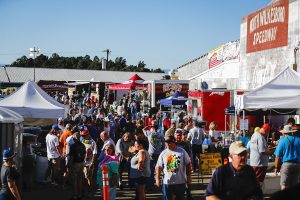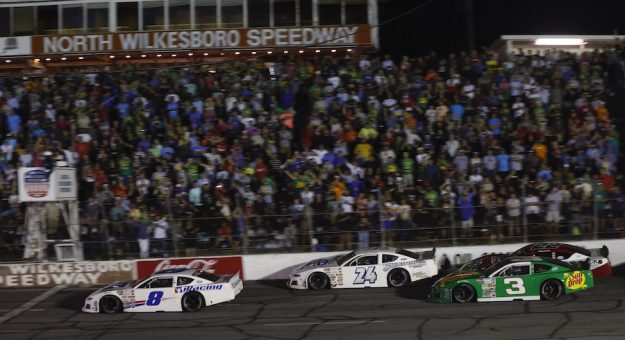Along the way, many have raced against tough-as-nails competitors such as Mike Looney, Lee Pulliam, Peyton Sellers, Deac McCaskill and Bobby McCarty, some of the very best in the class who have developed their own passionate fan bases throughout the Southeast.
Dubensky believes the mixture of experience not only helps young drivers develop race craft, but also allows them to develop their own following.
“Fans need to be able to become attached to you when you’re at that young age and then follow you all the way up through,” she explained. “You think about how many fans that are sitting in grandstands right now at NASCAR races that are still wearing the old T-shirts. In late model racing we have fan fests where the fans can come down and meet the drivers. … We have to get these fans attached to the drivers when they are younger.
“I think late model racing is extremely important for the accessibility that these fans can get to the drivers.”

Although Jared Fryar is still in his late 20s, he is one of those established short-track stars. Fryar is the grandson of two-time Snowball Derby winner Freddy Fryar, and his family has spent a lifetime in the sport.
Fryar won the 2018 CARS Tour super late model championship before turning his attention to late model stocks. He won the 2020 CARS Tour late model stock title and last season claimed both the NASCAR-sanctioned Hampton Heat 200 at Virginia’s Langley Speedway in late July and the November CARS Tour finale at Caraway Speedway in Sophia, N.C.
He also finished runner-up to Berry in the $50,000-to-win Thanksgiving Classic at North Carolina’s Southern National Motorsports Park on Thanksgiving weekend.
In 2022, Fryar and his team set their schedule to hit some of the year’s best-paying shows, which included the $10,000-to-win CARS Tour events and the series’ $30,000-to-the-victor Old North State Nationals program in the season opener at Caraway. He also competed in all three legs of the prestigious NASCAR-sanctioned Virginia Triple Crown (made up of the Thunder Road Harley-Davidson 200 at South Boston Speedway, the Hampton Heat 200 at Langley and the Valley Star Credit Union 300 at Martinsville Speedway), along with other notable late model stock events.
“In years past I haven’t been able to run that many high-paying races in one season,” Fryar said. “If you can get lucky enough and pick one up it’s definitely a huge boost for your whole race team.”
Fryar has driven a multitude of race cars during his career, but points to late model stocks as the most challenging, both in terms of driving the car and the competition level.
“The brake system and the weight of the car kind of fight against each other. They’re heavier than any other late model car out there and they have less braking power so that usually doesn’t go hand in hand,” Fryar explained. “But it makes for a better driver to be able to get around and go fast.”
Late model stocks are somewhat on an island in the short-track world, with each one utilizing an engine making just over 500 horsepower and weighing around 3,100 pounds. The cars are built on a perimeter chassis and feature single-piston brake calipers, a steering box (vs. rack-and-pinion), and often a truck trailing arm.
Rules packages currently allow for drivers like Fryar to bounce between CARS Tour events and NASCAR-sanctioned shows without a great deal needing to be changed; there are only slightly different engine rules and weights.
Instead, the major differences come in race procedures and lengths. Many NASCAR-sanctioned events count caution laps and utilize a choose cone on restarts, with pit strategy often coming into play for the longer races. Conversely, many CARS Tour shows are 125-lap sprints without counting laps run under yellow.
Fryar thinks having the attention of the upper echelon of the sport has contributed to the recent success of late model stock racing, but also notes racing at historic venues like North Wilkesboro and Martinsville (Va.) Speedway has elevated fan interest.
“I think being on stages like that really helped us get out there in front of new fans,” he said.
